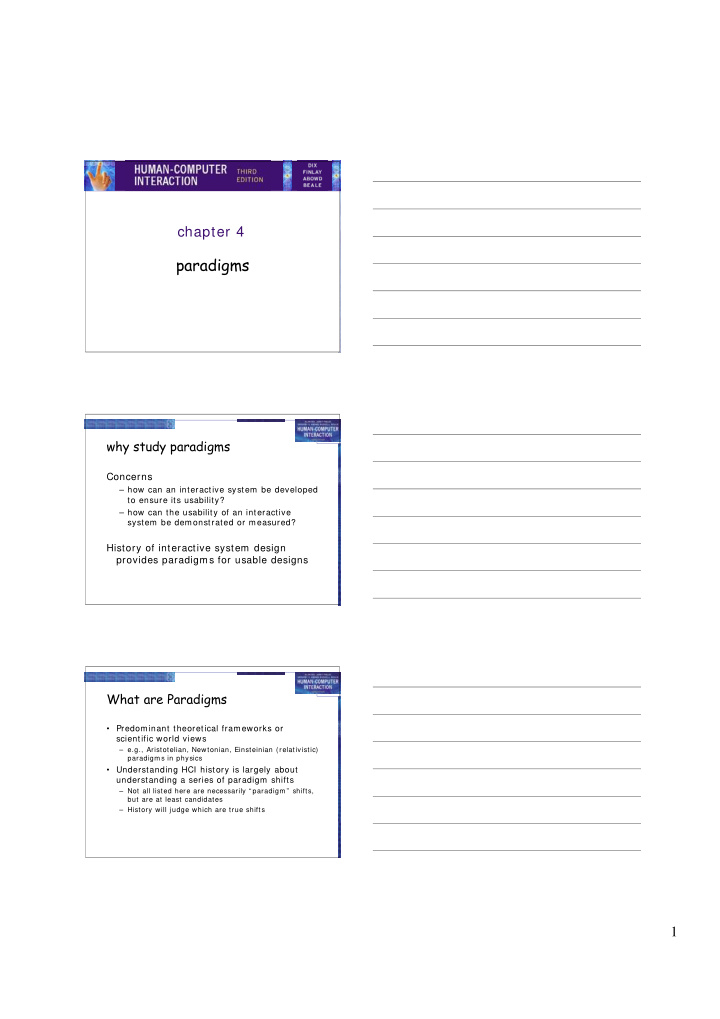



chapter 4 paradigms why study paradigms Concerns – how can an interactive system be developed to ensure its usability? – how can the usability of an interactive system be demonstrated or measured? History of interactive system design provides paradigms for usable designs What are Paradigms • Predominant theoretical frameworks or scientific world views – e.g., Aristotelian, Newtonian, Einsteinian ( relativistic) paradigm s in physics • Understanding HCI history is largely about understanding a series of paradigm shifts – Not all listed here are necessarily “ paradigm ” shifts, but are at least candidates – History will judge which are true shifts 1
Paradigms of interaction New computing technologies arrive, creating a new perception of the human—computer relationship. We can trace some of these shifts in the history of interactive technologies. The initial paradigm • Batch processing Impersonal computing Example Paradigm Shifts • Batch processing • Time-sharing Interactive computing 2
Example Paradigm Shifts • Batch processing @#$% ! • Timesharing • Networking ??? Community computing Example Paradigm Shifts • Batch processing C…P… filename Move this file here, dot star… or was • Timesharing and copy this to there. it R…M? • Networking • Graphical displays % foo.bar ABORT dumby!!! Direct manipulation Example Paradigm Shifts • Batch processing • Timesharing • Networking • Graphical display • Microprocessor Personal computing 3
Example Paradigm Shifts • Batch processing • Timesharing • Networking • Graphical display • Microprocessor • WWW Global information Example Paradigm Shifts • Batch processing • A sym biosis of physical and electronic worlds in • Timesharing service of everyday activities. • Networking • Graphical display • Microprocessor • WWW • Ubiquitous Computing Time-sharing • 1940s and 1950s – explosive technological growth • 1960s – need to channel the power • J.C.R. Licklider at ARPA • single com puter supporting m ultiple users 4
Video Display Units • m ore suitable medium than paper • 1962 – Sutherland's Sketchpad • computers for visualizing and manipulating data • one person's contribution could drastically change the history of com puting Programming toolkits • Engelbart at Stanford Research Institute • 1963 – augmenting man's intellect • 1968 NLS/ Augment system demonstration • the right program m ing toolkit provides building blocks to producing complex interactive system s Personal computing • 1970s – Papert's LOGO language for simple graphics programming by children • A system is m ore powerful as it becom es easier to user • Future of computing in small, powerful machines dedicated to the individual • Kay at Xerox PARC – the Dynabook as the ultim ate personal com puter 5
Window systems and the WIMP interface • humans can pursue more than one task at a tim e • windows used for dialogue partitioning, to “change the topic” • 1981 – Xerox Star first commercial windowing system • windows, icons, menus and pointers now fam iliar interaction m echanism s Metaphor • relating computing to other real-world activity is effective teaching technique – LOGO's turtle dragging its tail – file m anagem ent on an office desktop – word processing as typing – financial analysis on spreadsheets – virtual reality – user inside the m etaphor • Problem s – som e tasks do not fit into a given m etaphor – cultural bias Direct manipulation • 1982 – Shneiderman describes appeal of graphically-based interaction – visibility of objects – increm ental action and rapid feedback – reversibility encourages exploration – syntactic correctness of all actions – replace language with action • 1984 – Apple Macintosh • the model-world metaphor • What You See Is What You Get (WYSIWYG) 6
Language versus Action • actions do not always speak louder than words! • DM – interface replaces underlying system • language paradigm • interface as mediator • interface acts as intelligent agent • programming by example is both action and language Hypertext • 1945 – Vannevar Bush and the memex • key to success in managing explosion of inform ation • m id 1960s – Nelson describes hypertext as non-linear browsing structure • hypermedia and multimedia • Nelson's Xanadu project still a dream today Multimodality • a mode is a human communication channel • emphasis on simultaneous use of multiple channels for input and output 7
Computer Supported Cooperative Work (CSCW) • CSCW removes bias of single user / single computer system • Can no longer neglect the social aspects • Electronic mail is most prominent success The World Wide Web • Hypertext, as originally realized, was a closed system • Simple, universal protocols (e.g. HTTP) and mark-up languages (e.g. HTML) made publishing and accessing easy • Critical mass of users lead to a complete transformation of our information economy. Agent-based Interfaces • Original interfaces – Com m ands given to com puter – Language-based • Direct Manipulation/ WIMP – Com m ands perform ed on “ world” representation – Action based • Agents - return to language by instilling proactivity and “intelligence” in com m and processor – Avatars, natural language processing 8
Ubiquitous Computing “The most profound technologies are those that disappear.” Mark Weiser, 1991 Late 1980’s: computer was very apparent How to make it disappear? – Shrink and em bed/ distribute it in the physical world – Design interactions that don’t dem and our intention Sensor-based and Context- aware Interaction • Humans are good at recognizing the “context” of a situation and reacting appropriately • Automatically sensing physical phenomena (e.g., light, temp, location, identity) becoming easier • How can we go from sensed physical measures to interactions that behave as if made “aware” of the surroundings? 9
Recommend
More recommend